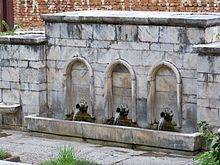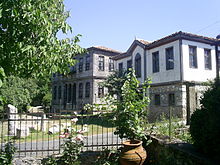Malko Tarnowo
| Malko Tarnowo (Малко Търново) | ||||
|
||||
| Basic data | ||||
|---|---|---|---|---|
| State : |
|
|||
| Oblast : | Burgas | |||
| Residents : | 2227 (December 31, 2016) | |||
| Coordinates : | 41 ° 59 ′ N , 27 ° 32 ′ E | |||
| Height : | 348 m | |||
| Postal code : | 8350 | |||
| Telephone code : | (+359) 05952 | |||
| License plate : | A. | |||
| administration | ||||
| Mayor : | Ivan Ivanov | |||
| Website : | visitmalkotarnovo.net | |||
Malko Tarnowo [ ˈmaɫko ˈtɤrnovo ] ( Bulgarian Малко Търново ) is a town in southeastern Bulgaria , in the Burgas Oblast in the middle of the Strandscha Mountains . Malko Tarnowo is the administrative center of the municipality of the same name, Malko Tarnowo.
geography
The city of Malko Tarnowo is located on the European route 87 in the immediate vicinity of the Bulgarian-Turkish border and the Malko Tarnowo-Dereköy border crossing . Malko Tarnowo is located in the Bulgarian part of the Strandscha Mountains in the central massif of the mountains. The city is also in the middle of the "Witanowo" reserve of the Strandscha nature park . There are many springs and ore deposits in the region.
history
Ancient and Middle Ages
Today Malko Tarnowo extends over a former Thracian settlement, large dolmens , old sanctuaries and barrows have been preserved. The center of the Thracian settlement is believed to be in the area of Golyamata tumba on the northwestern edge of the present-day city. Thracian remains from the Hellenic and Roman times can also be found in the current city center and in the southern part (graves, sculptor's studio, metal smelting furnaces, etc.) .
The settlement achieved economic and strategic importance, especially in late antiquity, thanks to the copper and iron ore deposits (exploitation verifiable from the 2nd to the 6th century) in the immediate vicinity of today's city. Corresponding melting furnaces were found at Malko Tärnovo. A dedicatory inscription (from 155/156 AD) was discovered in a temple of Apollo near Malko Tarnowo, which Straton, head of a group of iron mines, had built. The inscription may come from people who worked in the iron mines near Demirköy (Malak Samokov). Further on via Malko Tarnowo on an important north-south route connection from Sosopolis on the Black Sea to the Great Military Road at Arcadiopolis to Herakleia on the Marmara Sea . Other favorable road connections existed with the capital of the Odrysian Empire Uscudama (later Adrianopolis ), with Debeltos on the Gulf of Burgas in the north and with the port city of Bizye on the Black Sea in the east.
Up to 46 AD, the present-day city, like the entire region, belonged to the empire of the Odrysen , when they were finally defeated by the Romans. During this time a Roman way station ( statio milliaria ), possibly the Utsurgas, was built here. According to a dedicatory inscription created under Marcus Aurelius (161–180 AD), the settlement belongs to the city of Bizye, 49 km southeast.
Archaeological finds suggest that there was a settlement near Malko Tärnovo in the early Byzantine period and in the Middle Ages, albeit probably less significant. In the early Turkish times , Malko Tarnowo was the center of the area called Chasekijata .
Modern times
The present-day city emerged at the end of the 17th / beginning of the 18th century when the residents of the surrounding villages settled at the Golemija Wris spring . The original name of the city Tranowo probably goes back to the numerous distilleries (Tran) in the area. Later it became Tarnowo . To avoid confusion with the old Bulgarian capital Veliko Tarnowo , a Malko was added, which means small . During the Russo-Turkish War of 1828/29 , the city had around 3500 inhabitants who were mainly engaged in sheep breeding and the related crafts (tailors, cloth weavers, tanners ), but also in bricklaying and pottery, goldsmithing and Saddlery. Also marble mining was operated in the region. The marble of Istanbul's Dolmabahçe Palace comes from the region around Malko Tarnowo.
A convent school was opened at the beginning of the century, the first secular school in the 1840s, the girls' school in 1875. In the second half of the 19th century, Malko Tarnowo was a rich town with almost 8,000 inhabitants.
The Ilinden-Probraschenie uprising of 1903
In recent history, the city played an important role during the Ilinden-Preobraschenie uprising in 1903. This was organized and carried out by the Bulgarian Macedonia-Adrianople Revolutionary Committee , later VMRO . The city was the center of the so-called Strandscha region and part of the Adrianople combat area.
Near Malko Tarnowo in the Petrowa Niwa area , the Strandscha Republic was proclaimed on August 18, 1903 (Gregorian count) on the day of the Transfiguration of the Lord (Bulgarian: Probraschenie Day) . The republic elected Mikhail Gerdschikow , Stamat Ikonomow and Lasar Madscharow at its head. The aim of the uprising was to liberate as many Bulgarian areas as possible and to unite them with Bulgaria at a later date. The first fighting took place on August 19, 1903. In the first days of the uprising, the rebels managed to advance from the Bulgarian border in the north to Lozengrad in the south and thus to take over a large area from the Ottomans. The first cities to be captured were Ahtopol and Wasiliko .
The rebels were poorly armed and outnumbered: the Ottoman government sent an army of 350,000 soldiers with artillery and cavalry to meet the 26,000 rebels ; Russia did not intervene because Austria-Hungary and England were not interested in strengthening Russian influence in the Balkans.
Many insurgents died fighting or were executed, including popular figures such as Goze Deltschew and Pito Guli . Others, like Piperkata , committed suicide to avoid falling into the hands of the enemy. More than 70,000 people fled to neighboring countries, mainly Bulgaria. Most of the refugees ended up in Burgas .
In the last days of the uprising, the regular Ottoman army attacked more than 3,000 children, women and the elderly, all of them Bulgarian refugees, in the Petrowa Niwa area. This is still denied by Turkey today.
After the bloody suppression of the uprising, around 5000 residents of Malko Tarnowo had to leave their hometown. Every year on August 18 and 19, commemoration ceremonies take place throughout the region, the central celebration in the Petrowa Niwa area with senior state guests. Next to the memorial for the fallen insurgents is a museum dedicated to the Bulgarian freedom fighters in Strandscha , Thrace and Macedonia . In 2003 the Sveta Petka Church was consecrated.
It was not until 1912 that the city finally came to Bulgaria in the course of the First Balkan War .
Attractions
The two Thracian domed tombs near the city are particularly interesting. They were built from precisely hewn marble blocks and are a testament to the Thracian monumental architecture of the 5th – 3rd centuries. Century BC The archaeologists were able to draw their conclusions for the burial customs of Thracian aristocrats. Also to Roman times these burial places were used.
The first excavated, documented and published Thracian cult building (grave) - under a burial mound - is located five kilometers northeast of the city, in the Propada area. It was erected on top of a small hill and was the first on the necropolis of 40 other tombs. During investigations of two of these graves, additional graves from Roman times were discovered in 2001.
The grave in the Mishkowa Niwa area, 13 km southwest of the city, is impressive and monumental. It was used as a sanctuary or mausoleum of an outstanding Thracian ruler. It dates from the period 5-3. Century BC BC - the heyday of the Thracian culture.
More recently, the Uspenie Bogorodishtno Orthodox Church (Bulgarian Успение Богородично) is located in the center of Malko Tarnowo. It was built on the site of an older church from 1754. Several remains (ruins) of ancient churches are scattered in the city and the surrounding area.
In the city there is the Historical Museum, which with its five exhibitions is spread over three houses from the period of the Bulgarian Revival :
- Archaeological Museum
- Natural science museum
- New and newest story
- Icon painting
- ethnography
economy
Before 1990 mining was developed in the region and there was an ore enrichment plant, an electronics factory, construction companies, wood extraction, cattle breeding, a household chemistry and cosmetics plant. Today (as of 2007) the above industries have come to a standstill in the city. This is why unemployment and the emigration of young people are high.
Others
The New Bulgarian University , the University of Sofia and the South-West University Neofit Rilski (Blagoevgrad) jointly organize a summer university and expedition every summer under the title: "The Strandscha Mountains and their contribution to the civilizations of the East and West." - with the support of the Bulgarian municipality Malko Tarnowo and the Turkish municipality Lozengrad .
literature
- Peter Soustal: Thrace (Thrace, Rhodope and Haimimontos). Tabula Imperii Byzantini Vol. 6, Vienna 1991, ISBN 3-7001-1898-8 , p. 345.
gallery
Web links
Individual evidence
- ↑ The Witanowo Reserve (eng) ( Memento of the original from September 21, 2011 in the Internet Archive ) Info: The archive link was automatically inserted and not yet checked. Please check the original and archive link according to the instructions and then remove this notice.
- ↑ Structure of the nature park (eng) ( Memento of the original from August 17, 2016 in the Internet Archive ) Info: The archive link was inserted automatically and has not yet been checked. Please check the original and archive link according to the instructions and then remove this notice.
- ↑ a b c Soustal, p. 345
- ↑ Soustal, p. 151
- ↑ Soustal, p. 145.
- ↑ Archived copy ( memento of the original dated August 11, 2008 in the Internet Archive ) Info: The archive link has been inserted automatically and has not yet been checked. Please check the original and archive link according to the instructions and then remove this notice. Site of the municipality of Malko Tarnowo











